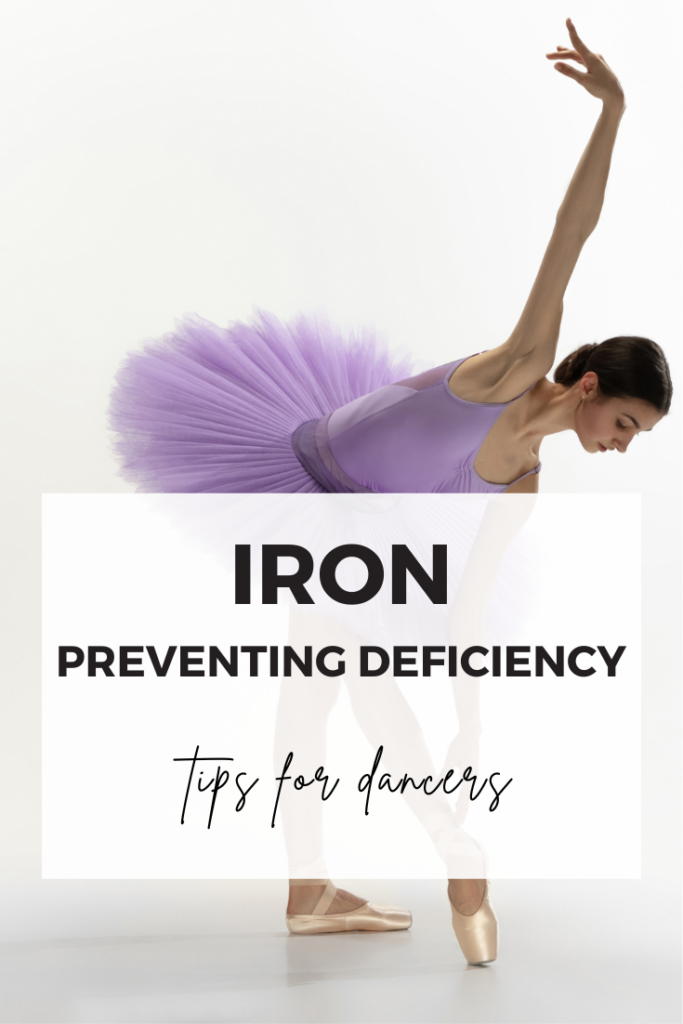Iron is a notable mineral relied upon by athletes for performance success— so much so that the International Olympic Committee recommends iron screenings during health evaluations. Despite a dancer’s needs being comparable to those of an athlete, iron remains overlooked. In a study of female ballet dancers, more than half were reported to be iron deficient. This is on top of the established prevalence of iron deficiency in adolescent females.
Why are dancers struggling to maintain their iron status? In this blog post, we will explore the importance of iron for dancers and how it contributes to their overall performance and well-being.
Why is iron important for dancers?
Iron plays a pivotal role in the transportation of oxygen throughout the body. It’s a key component of hemoglobin, the protein found in red blood cells. Hemoglobin is responsible for carrying and delivering oxygen from your lungs to your muscles and brain— cue stamina and focus.
Why are dancers at risk for iron deficiency?
There are a few reasons. Restrictive dieting and disordered eating leave dancers with limited variety in their meal plans. The same is true for dancers who rely on selective diets for food allergies/intolerances (such as gluten-free diets for Celiac disease). The prevalence of “clean” eating can also drive dancers away from otherwise iron-rich foods like red meat and fortified grain products (breads and cereals).
Plant-based dancers, specifically vegetarians, and vegans, are also more susceptible to iron deficiency. In comparison to animal-based iron-rich foods (meat, poultry, eggs), the iron from plants (also called non-heme iron) is less bioavailable. So while these foods might contain iron, it’s both less absorbable and not as efficiently utilized by the body. Couple this with restrictive eating and the risk for iron deficiency becomes twofold.
While these reasons are, arguably, modifiable for dancers in thinking about prevention measures against iron deficiency, other non-modifiable risk factors exist. Menstruation, particularly in dancers with heavier periods, leads to blood loss and ultimately, reduced iron levels. In addition to this is the normal impact of exercise on iron metabolism. The body’s ability to absorb and utilize iron from food and supplements is inhibited for more than three hours after intense and prolonged exercise (like dancing)— a suspected result of inflammation.
How do I know if I’m iron deficient?
Identifying iron deficiency is challenging for dancers who, at baseline, will experience a natural ebb and flow of fatigue from their busy and active schedules. If you’re concerned, start by identifying the risk factors mentioned earlier:
- Are you dancing more than 15-20 hours per week?
- Does a busy schedule prevent you from eating enough each day?
- Are you a vegetarian or vegan dancer?
- Do you struggle with disordered eating?
- Are you attempting to abide by strict “clean” eating rules?
- Do you experience regular heavy periods?
Dancers with optimal iron levels are better equipped to endure long rehearsals and intense performances without overwhelming fatigue. However, not every dancer who experiences fatigue will be iron deficient. Severe iron deficiency can lead to anemia, characterized by weakness, dizziness, and decreased performance capabilities. Your best bet? Consult with a medical doctor for bloodwork—this will offer an easy evaluation of your iron status.
A food-first approach: Iron
To ensure you’re meeting your iron requirements as a dancer, make a proactive effort to include iron-rich foods in your diet. Protein-rich foods, particularly red meat, shellfish, and eggs (including the yolk) will be great sources of the more absorbable heme iron. Plant-based foods like leafy greens, legumes, nuts, and seeds are excellent sources of non-heme iron.
For plant-based dancers, pair iron-rich foods with foods high in vitamin C. For example, squeeze lemon on your leafy greens and top grain-based dishes with tomatoes. Vitamin C is known to enhance iron absorption, promoting overall iron balance. The Healthy Dancer® Survival Guide for Plant-Based Lifestyle will also be a great tool for you.
Should I take iron supplements?
A recent study showed the benefit of temporary (8 weeks) iron supplementation in increasing blood ferritin levels in elite dancers while dancing. However, if you’re considering a supplement, it’s first encouraged that you meet with both your medical doctor (for a blood test) and a Registered Dietitian Nutritionist to help with meal-planning techniques that combat the obstacles mentioned earlier (like under-fueling and disordered eating).
Iron for Dancers: Key Takeaways
Maintaining adequate iron levels is essential for dancers. By incorporating iron-rich foods into their diet, dancers can ensure they have the energy and stamina to excel in the studio.
Dancer-friendly foods rich in iron:
- Red Meat: Incorporate sources like beef, chicken, and turkey. These provide heme iron, which is easily absorbed by the body.
- Leafy Greens: Spinach, kale, and Swiss chard are excellent plant-based sources of non-heme iron. Pair them with vitamin C-rich foods to enhance iron absorption.
- Legumes: Beans, lentils, and chickpeas are not only rich in iron but also offer a protein boost, supporting muscle repair and development.
- Nuts and Seeds: Almonds, pumpkin seeds, and sunflower seeds are iron-packed snacks that dancers can enjoy on the go.
Quick iron-rich recipes for dancers:
#1: Beef and Spinach Stir-Fry
Ingredients:
- Beef strips
- Fresh spinach
- Rice
- Garlic
- Soy sauce
Directions: Sauté beef with oil and garlic, add spinach, and stir-fry until cooked. Serve atop a bed of rice. Finish with soy sauce.
#2: Quinoa Salad with Chickpeas:
Ingredients:
- Quinoa
- Chickpeas
- Cherry tomatoes
- Cucumber
- Feta cheese
- Vinaigrette
Directions: Mix cooked quinoa with chickpeas and veggies. Top with feta and vinaigrette.
#3: Lentil Soup:
Ingredients:
- Lentils
- Carrots
- Celery
- Onion
- Vegetable broth
- Oil
Directions: Simmer lentils and veggies in broth until tender. Season to taste.




